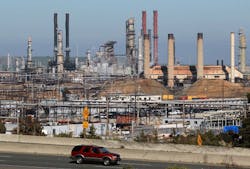CSB Proposes Major Changes to California’s Process Safety Management Regulations
Sparked by the August 2012 explosion at Chevron’s Richmond, Calif., refinery, the U.S. Chemical Safety Board is calling on California to update its process safety management standards for petroleum refineries.
“The current regulatory system for process safety is largely reactive, at both the state and federal level. Companies have a default right to operate, and are subject to penalties when accidents occur or their activities otherwise draw negative attention from regulators,” CSB Chairman Dr. Rafael Moure-Eraso said. “In the case of the Chevron refinery fire, the reactive system of regulation simply did not work to prevent what was ultimately a preventable accident.”
On Aug. 6, 2012, in the refinery’s No. 4 crude unit, a pipe ruptured and spewed hydrocarbon process fluid, creating a large vapor cloud that engulfed 19 Chevron employees and ignited. Although the employees escaped and narrowly avoided serious injury, some 15,000 local residents sought medical treatment from exposure to particulates and vapor.
The CSB report – the second of three related to the Chevron incident – calls on California to enhance its process safety management regulations for petroleum refineries “to ensure a more robust and adaptive regulatory regime.”
The report calls for:
- A more comprehensive process hazard analysis.
- Documented use of inherently safer systems analysis and the hierarchy of controls to the greatest extent feasible with the goal of continuous risk reduction to a specified risk target.
- Analysis of the effectiveness of safeguards intended to control hazards.
- The effective use of process safety indicators that drive performance.
- More thorough inspections and audits by a technically qualified regulator.
CSB asserted that the changes “would provide the adaptability necessary to keep current with improving standards and advancing technology, without requiring lengthy and often unproductive rulemaking on the part of the regulator.”
“Effective implementation of this system requires strong workforce involvement, proactive inspections and enforcement by a well-resourced regulator, as well as incorporation of best practice performance standard requirements,” the agency added.
Don Holmstrom, director of the CSB’s Western Regional Office, noted that the Chevron report recommends regulatory changes that would empower workers and their representatives.
“The report recommends that the regulator recognize worker safety representatives who have the right to participate in improvements to process safety and if necessary have the legal authority to stop unsafe work,” Holmstrom said. “The Chevron incident showed these reforms are sorely needed.”
Missed Opportunities
CSB said its investigation found that Chevron over a 10-year period repeatedly failed to apply inherently safer design principles and upgrade piping in its crude-oil processing unit, which was extremely corroded and ultimately ruptured on Aug. 6, 2012.
CSB’s first report asserted that Chevron missed opportunities to apply inherently safer piping design through the use of more corrosion-resistant metal alloys. The first report also concluded that Chevron failed to identify and evaluate damage mechanism hazards, which if acted upon, likely would have identified the possibility of a catastrophic sulfidation corrosion-related piping failure, according to the agency.
CSB noted that there are no federal or state regulatory requirements to apply the preventative measures recommended in its reports. The investigation team concluded that enhanced regulatory oversight with greater worker involvement and public participation are needed to improve petroleum refinery safety.
“Workers, the public and the industry itself would benefit from an adaptable, robust and effective regulatory approach,” Moure-Eraso said. “The recent bipartisan law passed last month by the California Legislature to provide regulators with detailed information concerning extensive maintenance overhauls and repair operations at refineries within the state is certainly a step in the right direction.”
On Sept. 9, in response to the Chevron incident, Cal/OSHA released a draft of its Process Safety Management for Refineries regulation. The draft regulation incorporates a risk-reduction goal of “the greatest extent feasible” for process hazard analyses and proposes significant new requirements such as performing damage mechanism reviews and hierarchy of controls analysis.
“California’s draft regulations address numerous issues raised in the CSB regulatory report, and the CSB will be monitoring the California rulemaking process closely to see if those provisions remain in the final rule,” Moure-Eraso said.
In mid December, CSB will hold a public meeting to unveil its third report on the Chevron incident.
